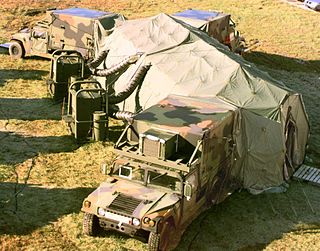
The Direct Air Support Center (DASC) is the principal United States Marine Corps aviation command and control system and the air control agency responsible for the direction of air operations directly supporting ground forces. It functions in a decentralized mode of operation, but is directly supervised by the Marine Tactical Air Command Center (TACC) or the Navy Tactical Air Control Center (NTACC). During amphibious or expeditionary operations, the DASC is normally the first Marine Air Command and Control System (MACCS) agency ashore and is usually categorized as the Ground Combat Element's (GCE's) senior Fire Support Coordination Center (FSCC). The DASC's parent unit is the Marine Air Support Squadron (MASS) of the Marine Air Control Group (MACG).

Marine Air Support Squadron 3 (MASS-3), is a United States Marine Corps aviation command and control unit that provides the Direct Air Support Center (DASC) for the 1st Marine Expeditionary Force. They are based out of the 32 Area on Marine Corps Base Camp Pendleton, California and fall under the command of Marine Air Control Group 38 and the 3rd Marine Aircraft Wing.

Marine Light Attack Helicopter Squadron 369 (HMLA-369) is a United States Marine Corps helicopter squadron consisting of AH-1Z Viper attack helicopters and UH-1Y Venom utility helicopters. The squadron, also known as the "Gunfighters", is based at Marine Corps Air Station Camp Pendleton, California and falls under the command of Marine Aircraft Group 39 (MAG-39) and the 3rd Marine Aircraft Wing.

Marine Light Attack Helicopter Squadron 169 (HMLA-169) is a United States Marine Corps helicopter squadron consisting of AH-1Z Viper attack helicopters and UH-1Y Huey utility helicopters. The squadron is based at Marine Corps Air Station Camp Pendleton, California and falls under the command of Marine Aircraft Group 39 (MAG-39) and the 3rd Marine Aircraft Wing.

Marine Air Support Squadron 2 (MASS-2), is a United States Marine Corps aviation command and control unit that provides the Direct Air Support Center (DASC) for the III Marine Expeditionary Force. It is the oldest and most decorated aviation command and control unit in the Marine Corps.
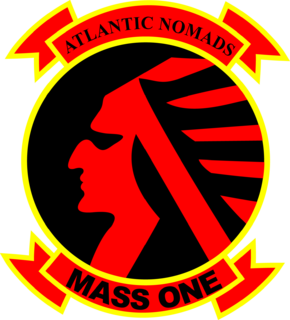
Marine Air Support Squadron 1 (MASS-1), callsign "Chieftain," is a United States Marine Corps aviation command and control unit that provides the Direct Air Support Center (DASC) capability for the II Marine Expeditionary Force. MASS-1 is based out of Marine Corps Air Station Cherry Point, North Carolina, and part of Marine Air Control Group 28 of the 2nd Marine Aircraft Wing.

Marine Wing Support Squadron 372 is an aviation ground support unit of the United States Marine Corps. Known as the "Diamondbacks", they are based out of Marine Corps Base Camp Pendleton, California. The squadron falls under the command of Marine Aircraft Group 39 and the 3rd Marine Aircraft Wing.
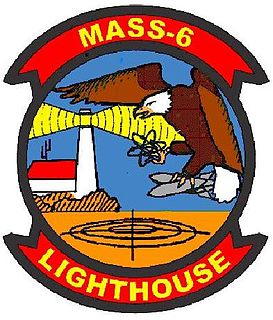
Marine Air Support Squadron 6 (MASS-6), is a reserve United States Marine Corps aviation command and control unit that provides the Direct Air Support Center (DASC) for the Marine Forces Reserve. Their headquarters is in Westover Air Reserve Base, Massachusetts and their Detachment Alpha is located at Marine Corps Air Station Miramar, California

Marine Air Control Squadron 1 (MACS-1) is a United States Marine Corps aviation command and control squadron. The squadron provides aerial surveillance, air traffic control, ground-controlled intercept, and aviation data-link connectivity for the I Marine Expeditionary Force. It was the first air warning squadron commissioned as part of the Marine Corps' new air warning program and is the second oldest aviation command and control unit in the Marine Corps. The squadron is based at Marine Corps Air Station Yuma and falls under Marine Air Control Group 38 and the 3rd Marine Aircraft Wing.

Marine Air Control Squadron 2 (MACS-2) is a United States Marine Corps aviation command and control squadron. The squadron provides aerial surveillance, Ground-controlled interception, and air traffic control for the II Marine Expeditionary Force. They are based at Marine Corps Air Station Cherry Point and fall under Marine Air Control Group 28 and the 2nd Marine Aircraft Wing.

Marine Aviation Logistics Squadron 39 (MALS-39) is an aviation logistics support unit of the United States Marine Corps. Known as the "Hellhounds", they fall under the command of Marine Aircraft Group 39 (MAG-39) and the 3rd Marine Aircraft Wing and are currently based at Marine Corps Air Station Camp Pendleton, California..

Marine Tactical Air Command Squadron 18 (MTACS-18) is a United States Marine Corps aviation command and control unit based at Marine Corps Air Station Futenma. They provide the 1st Marine Aircraft Wings tactical headquarters and command other units within Marine Air Control Group 18 when deployed.
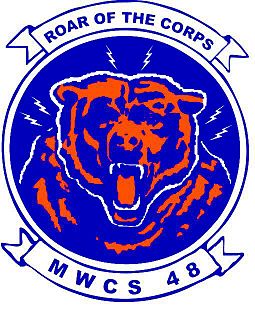
Marine Wing Communications Squadron 48 is a communications squadron in the United States Marine Corps Reserve. As part of Marine Air Control Group 48, MWCS-48 provides expeditionary communications for the 4th Marine Aircraft Wing, the Aviation Combat Element of Marine Forces Reserve. They are based at Naval Station Great Lakes and fall under the command of Marine Air Control Group 48 and the 4th Marine Aircraft Wing.

Marine Wing Communications Squadron 28 (MWCS-28) is a United States Marine Corps communications squadron. The squadron provides expeditionary communications for the aviation combat element of the II Marine Expeditionary Force. They are based at Marine Corps Air Station Cherry Point and fall under the command of Marine Air Control Group 28 and the 2nd Marine Aircraft Wing.

Marine Air Control Squadron 7 (MACS-7) was a United States Marine Corps aviation command and control squadron. The squadron provided aerial surveillance and ground-controlled interception and saw action most notably during the Battle of Okinawa in World War II and the Vietnam War. They were last based at Marine Corps Air Station Yuma and fell under the command of Marine Air Control Group 38 (MACG-38) and the 3rd Marine Aircraft Wing.
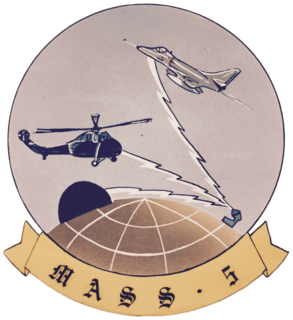
Marine Air Support Squadron 5 (MASS-5) was a United States Marine Corps aviation command and control unit that provided the Direct Air Support Center (DASC) capability for the I Marine Expeditionary Force from 1966 through 1969. MASS-5 was headquartered at Marine Corps Air Station El Toro, California, and was part of Marine Air Control Group 38 and the 3rd Marine Aircraft Wing.
Air Warning Squadron 6 (AWS-6) was a United States Marine Corps aviation command and control unit that provided aerial surveillance and early warning of enemy aircraft during World War II. The squadron was activated on January 1, 1944 and was one of five Marine Air Warning Squadrons that provided land based radar coverage during the Battle of Okinawa in 1945. AWS-6 remained on Okinawa as part of the garrison force following the Surrender of Japan. The squadron departed Okinawa for the United States in February 1946 and was quickly decommissioned upon its arrival in California. To date, no other Marine Corps squadron has carried the lineage and honors of AWS-6 to include Marine Air Control Squadron 6 (MACS-6).

Marine Air Control Squadron 8 (MACS-8) was a United States Marine Corps aviation command and control squadron. The squadron provided aerial surveillance and ground-controlled interception (GCI). Originally formed in World War II as Air Warning Squadron 18 (AWS-18), the squadron served as a training and replacement unit until it was decommissioned in April 1947 as part of the post war drawdown of forces. Reactivated in 1952 during the Korean War the squadron took part in numerous Far East deployments during the 1960s. Transferred to Japan in 1969, the squadron was decommissioned in 1971 as the last Marine Corps units were departing South Vietnam. They were last based at Marine Corps Air Station Futenma, Okinawa, Japan and fell under the command of Marine Air Control Group 18 (MACG-18) and the 1st Marine Aircraft Wing.

Marine Air Control Squadron 3 (MACS-3) was a former United States Marine Corps aviation command and control squadron. During its later years it also served as an operational test and evaluation squadron. Originally formed in World War II as Air Warning Squadron 12 (AWS-12), its original mission was to provide aerial surveillance and ground-controlled interception (GCI) for Marine Corps forces during amphibious operations. The squadron did not participate in combat operations during WWII however it did deploy and operate during the Korean War. In 1961, MACS-3 was transferred from the Fleet Marine Force to the administrative control of Air, Fleet Marine Forces Pacific in order to serve as the operational test and evaluation squadron for what was at the time, the largest research and development project in the Marine Corps - Marine Tactical Data System (MTDS). After MTDS testing was complete the Marine Corps recognized that it was not properly staffed to develop, test, and acquire new digital equipment. On 1 July 1970, MACS-3 was decommissioned and its structure and equipment were utilized to form Marine Corps Tactical Systems Support Activity (MCTSSA) at Marine Corps Base Camp Pendleton, California. Of note, MCTSSA does not carry MACS-3's lineage and honors.



















